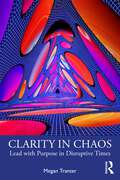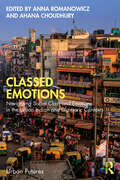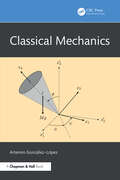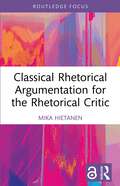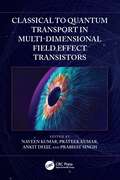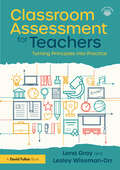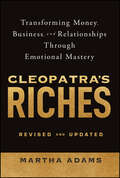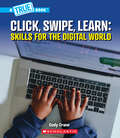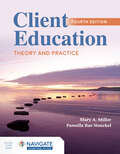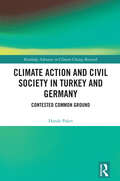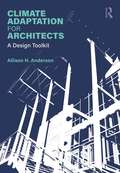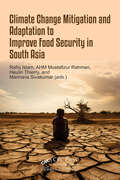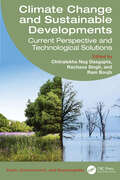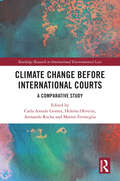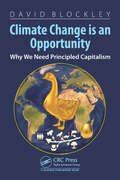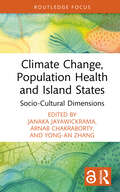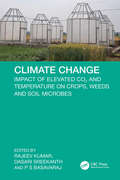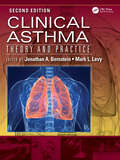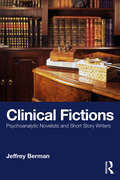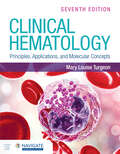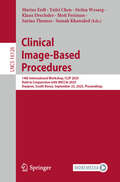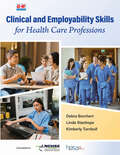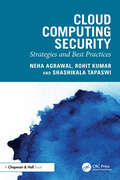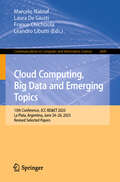- Table View
- List View
Clarity in Chaos: Lead with Purpose in Disruptive Times
by Megan TranterWith its fresh and deeply personal perspective on what it takes to lead with resilience and authenticity, this book challenges the traditional playbook on leadership by placing purpose at the core of every decision and action.In a world increasingly defined by uncertainty and rapid change, leadership grounded in purpose is the compass that transforms uncertainty into impact, stagnation into growth, and vision into a legacy. Drawing on her extraordinary journey from technical safety expert to global executive, Megan Tranter weaves together compelling personal anecdotes, cutting-edge research, and practical tools to show how leaders can redefine success. But this book goes beyond strategies to invite readers into an authentic dialogue about vulnerability, growth, and the kind of leadership that transforms lives – not just spreadsheets. Readers will be left feeling understood, inspired, and empowered to take courageous actions in their careers, solving the pervasive problems of burnout, disconnection, and lack of fulfillment.This book is the roadmap for seasoned executives and aspiring leaders to unlock their potential and lead with clarity and conviction.
Classed Emotions: Navigating Social Class and Emotions in the Urban Indian and Diasporic Contexts (Urban Futures)
by Anna Romanowicz Ahana ChoudhuryThis book explores how urban spaces encompass, shape and reconfigure the emotional landscapes and socio-cultural specters of their inhabitants. It highlights the arenas in which various politics and strategies of emotional relations are represented, created, enacted and regulated through the inhabitants’ lives and lifestyles. Exploring this, the chapters in the volume bring together and analyze the myriad forms of intersections within and between urban centers in India and the Indian diaspora, as well as ‘classed’ emotions. The authors embark on scholarly inquiries to highlight the complex and fluid dynamics through which urban spaces and the class of their inhabitants question, attribute, influence and perpetuate the diverse emotional states and responses, and vice versa – they examine the ways in which emotive subjectivities, relations, experiences and practices question and influence multiple urban formations, power dynamics and spaces. They reveal how emotional and urban landscapes are not only represented but are also affected by the social class of the denizens. Part of the Urban Futures series, the volume will be indispensable to scholars and researchers of urban studies, anthropology, sociology, cultural studies, urban planning, urban policy, public policy and architecture. It will also be of interest to the professional architects, urban designers, social geographers and policymakers.
Classical Mechanics
by Artemio González–LópezClassical Mechanics is a textbook for undergraduate students majoring in Physics (or Mathematics and Physics). The book introduces the main ideas and concepts of Newtonian, Lagrangian, and Hamiltonian mechanics, including the basics of rigid body motion and relativistic dynamics, at an intermediate to advanced level. The physical prerequisites are minimal, with a short primer included in the first chapter. As to the mathematical prerequisites, only a working knowledge of linear algebra, basic multivariate calculus, and the rudiments of ordinary differential equations is expected.Features Numerous exercises and examples A focus on mathematical rigor that will appeal to Physics students wanting to specialize in theoretical physics, or Mathematics students interested in math- ematical physics Sufficient material to service either a one- or two-semester course
Classical Mechanics: A Computational Approach with Examples Using Mathematica and Python
by Vasilis Pagonis Christopher W. KulpClassical Mechanics: A Computational Approach with Examples using Python and Mathematica provides a unique, contemporary introduction to classical mechanics, with a focus on computational methods. In addition to providing clear and thorough coverage of key topics, this textbook includes integrated instructions and treatments of computation.This newly updated and revised second edition includes two new appendices instructing the reader in both the Python and Mathematica languages. All worked example problems in the second edition contain both Python and Mathematica code. New end-of-chapter problems explore the application of computational methods to classical mechanics problems.Full of pedagogy, it contains both analytical and computational example problems within the body of each chapter. The example problems teach readers both analytical methods and how to use computer algebra systems and computer programming to solve problems in classical mechanics. End-of-chapter problems allow students to hone their skills in problem solving with and without the use of a computer. The methods presented in this book can then be used by students when solving problems in other fields both within and outside of physics.It is an ideal textbook for undergraduate students in physics, mathematics, and engineering studying classical mechanics.Key Features: Gives readers the "big picture" of classical mechanics and the importance of computation in the solution of problems in physics Numerous example problems using both analytical and computational methods, as well as explanations as to how and why specific techniques were used Online resources containing specific example codes to help students learn computational methods and write their own algorithms A solutions manual is available via the Routledge Instructor Hub and all example codes in the book are available via the Support Material tab, and at the book’s GitHub page: https://github.com/vpagonis/Classical_Mechanics_2nd_Edition
Classical Rhetorical Argumentation for the Rhetorical Critic (Routledge Studies in Rhetoric and Communication)
by Mika HietanenThis book offers a reassessment of argumentation in classical rhetoric, foregrounding its rational dimension. Moving beyond introductions, it provides insights from Aristotle, Quintilian, and other ancient thinkers while addressing common misconceptions and offering clarifications that are particularly valuable for the rhetorical critic.Adopting a Scandinavian rhetorical perspective, this book argues that classical rhetoric offers enduring tools for both the analysis and the construction of persuasive argumentation. By bridging theory and practice, it demonstrates how classical rhetoric remains highly relevant, while also naturally integrating with analyses that focus on classical concepts such as ethos, pathos, or style – whether through neo‑Aristotelian methods or contemporary approaches rooted in the classical rhetorical tradition. Key concepts are explored in dedicated chapters: the ‘art’ of logos‑based argumentation is reassessed; enthymeme and epicheireme structures are examined; and topoi and staseis are discussed in relation to their later developments. A chapter on the centenary of rhetorical criticism traces its evolution from Herbert Wichelns (1925) to today, proposing a new template for the rhetorical critic.This concise yet comprehensive book will interest intermediate and advanced students, as well as scholars of rhetoric, argumentation, persuasion, speech and writing studies, and communication studies.
Classical to Quantum Transport in Multi-Dimensional Field Effect Transistors
by Naveen Kumar Ankit Dixit Prateek Kumar Prabhat SinghClassical to Quantum Transport in Multi‑Dimensional Field Effect Transistors offers a wide range of topics with attractive images and informative explanations. It begins with an exploration of the fundamentals of field effect transistor (FET) functioning, emphasizing how behavior is governed by classical models. As the semiconductor industry pushes the boundaries of miniaturization and performance, Multi-Dimensional Field Effect Transistors (MuDFETs) and emerging material platforms are redefining the foundations of modern electronics. This book offers a deep and insightful journey through the evolving landscape of advanced FET architectures—from classical conduction models to quantum and ballistic transport regimes. Authored by experts across academia and research institutions, this book offers in-depth discussions on:• Multi-Dimensional and Junctionless FETs: Design innovations enabling superior control, scaling, and performance.• 2D Materials & Transition Metal Dichalcogenides (TMDCs): Harnessing atomically thin semiconductors for next‑generation device engineering.• Nanosheet Transistors: Unlocking new dimensions in charge transport and quantum confinement.• Charge transport mechanisms from classical, semiclassical to ballistic regimes in nanosheet and nanowire FETs.• Tunnel Field Effect Transistor (TFET)-Based Biosensors: Cutting-edge developments in label‑free, ultra-sensitive detection for healthcare and environmental monitoring.• Integration of FET platforms in nonlinear and quantum photonics using silicon nitride waveguides.Whether you’re exploring the quantum limits of device physics or developing real-world sensing solutions, this collection bridges theory and application in one compelling volume. With contributions from leading researchers and technologists, this book serves as a vital reference for academics, graduate students, and professionals working in nanoelectronics, semiconductor devices, biosensors, and photonic field.
Classroom Assessment for Teachers: Turning Principles into Practice
by Lena Gray Lesley Wiseman-OrrThis accessible guide shows just how straightforward it can be to create excellent classroom assessment for formative or summative purposes, giving you confidence in your assessment practices.It clearly sets out the principles underpinning all good educational assessment and translates them into a series of clear practical steps. These can be put into practice in a wide range of classroom contexts to fit the purposes of every teacher. Written by two assessment specialists with decades of experience in the UK and internationally, this readable and well-structured text encourages teachers to examine assumptions and challenge the use of assessment that is not fit for purpose. Including summaries of key ideas, questions and key takeaways, chapters cover: The purposes of educational assessment Understanding what you want to assess How to get the evidence you need Assessment design The outcomes of assessment and providing feedback Designed to inspire and support busy teachers and teachers in training across both primary and secondary phases, this book is a valuable resource for creating the kinds of assessment that will benefit learners in the ways that all good assessment should.
Cleopatra's Riches: Transforming Money, Business, and Relationships Through Emotional Mastery, Revised and Updated
by Martha AdamsA new edition of the guidebook to transforming your relationship with money In the newly revised edition of Cleopatra’s Riches: Transforming Money, Business, and Relationships Through Emotional Mastery, internationally renowned Certified Financial Planner and financial educator, Martha Adams, reveals a transformative new way to think and feel about, and engage with, money. She offers a fresh, human-centered approach that puts you at the heart of your own personalized financial journey. This book is the key to regaining your financial power and redefining your emotional relationship with money. You’ll rediscover money as a source of joy, growth, and purpose as you navigate the author’s one-of-a-kind 4R Process.™ Inside the book: Move from a mindset of financial anxiety to financial empowerment by reshaping your emotional associations with money Nurture your emotional well-being by ensuring that your money decisions improve your wealth and mental health Apply the 4R Process™ to key areas of your life, including business and entrepreneurship, couples, family, and leadership This isn’t just a book about managing dollars and cents or understanding your household’s balance sheet. Cleopatra’s Riches is a custom roadmap to mastering your money mindsets and imbuing your financial outlook with confidence, clarity, and compassion.
Click, Swipe, Learn: Skills for the Digital World (A True Book)
by Cody CraneHow can kids use the internet smartly? Discover it with this step-by-step guide for young readers.Kids spend about five hours a day connecting with digital content-consuming it and/or creating it. Some of that content might include misinformation and altered images. It may even promote biases or dangerous ideas. Creating content includes pitfalls too-from copyright infringement to posting information that could be harmful or damaging. That's why digital literacy is so important. Click, Swipe, Learn: Skills for the Digital World uses engaging, interactive text-including critical-thinking questions-to show kids exactly what they need to watch out for as they navigate the digital world.ABOUT THIS SERIES:The world of media and technology is changing fast-and young students are right there in the thick of it. As children try to make sense of new technologies, they face a variety of critical issues, including how to access reliable sources of information, how to protect themselves online, and how to use technology in mindful and respectful ways. That's where the books in the Our Digital Future series can help. Each title has been developed to help young readers think critically and navigate new technologies with confidence and care.
Client Education: Theory and Practice
by Mary A. Miller Pamella Rae StoeckelClient Education: Theory and Practice, Fourth Edition teaches nursing students the important skills of patient education and health promotion. The authors use their unique Miller-Stoeckel Client Education Model as the organizing framework to emphasize the importance of the Nurse-Client Relationship and how this relationship is paramount to the success of client education. They focus on the key role that nurses play in educating individuals, families and groups in clinical settings. The updated Fourth Edition addresses the need for health education in nursing by covering the learning process and discussing the needs of clients across the age span. The authors’ thoughtful revision includes updated statistics on chronic diseases and new data on generations Z and Alpha. Furthermore, they teach students how to work with culturally diverse populations by presenting specific teaching approaches.
Climate Action and Civil Society in Turkey and Germany: Contested Common Ground (Routledge Advances in Climate Change Research)
by Hande PakerThis book explores the social and political dynamics that shape the impacts of climate change, drawing upon Turkey and Germany to offer a comprehensive comparative analysis.Civil society representatives, the climate movement, the youth, and arts and culture actors from around the world unequivocally call for a deep transformation of political, economic, and social structures in order to avoid the devastating effects of climate change. The transformation that is prescribed is perceived as insufficient, technocratic, and market-based and does not involve challenging power relations at the heart of climate action. This book addresses these concerns, using a comparative analysis to explore the issues and efficiency of a meaningful sustainable transition. The in-depth comparison of two conventionally dissimilar cases, Turkey and Germany, demonstrates that civil society actors in different political settings can use similar strategies and frames for climate action against state actors. In turn, states use similar depoliticization strategies (albeit via different mechanisms) and economic growth narratives to reproduce hegemony. The book untangles the different processes that create the contentious, politicized common ground in which these stakeholders interact with each other. The findings of this research have significant implications for many developing and developed countries alike where climate policymaking is painstakingly inadequate.This book will be of interest to students, researchers, and academics interested in political ecology, climate politics, and politics of development.
Climate Adaptation for Architects: A Design Toolkit
by Allison AndersonArchitecture must adapt to protect people from the threat of climate change. About half of the world’s population lives in contexts that are highly vulnerable to climate change as hazards continue to intensify, with global disasters projected to reach 560 events per year by 2030, or 1.5 events every day. The accelerating frequency and intensity of disasters underscores the urgency to prepare for severe events to protect people, communities, and essential systems but also to protect the environment which provides shelter, livelihoods, cultural heritage, and public functions. This book provides a comprehensive reference of climate adaptation design tactics and a toolkit for adaptation to shocks and stresses, outlining the process for architects and designers to: Understand the risks posed by climate change to the built environment. Reduce the risks to people and the built environment from natural hazards. Reduce human vulnerability to shocks and stresses by strengthening resilience and adaptive capacity. Design the built environment to adapt to changes over its lifetime. Design buildings and cities to reduce dependence on fossil fuels. Preserve biodiversity and support natural resources. Climate Adaptation for Architects presents 45 adaptation tactics responding to the most consequential effects of climate change: heat, water, wind, and resource scarcity. Each chapter includes images, a definition, background information, key design considerations, potential impacts, and resources for further information. This is a valuable resource for every architect, landscape architect, urban planner, developer, and policymaker.
Climate Change Mitigation and Adaptation to Improve Food Security in South Asia
by Mannava Sivakumar Rafiq Islam Heulin Thierry Ahm Mustafizur RahmanBoth food security and agriculture contribute to, and are affected by, global climate change. The Intergovernmental Panel on Climate Change reports that food production systems account for up to 37% of global greenhouse gas emissions. At the same time, these systems are increasingly vulnerable to climate change, with extreme weather events such as rising temperatures, flooding, drought, secondary salinity, and land degradation threatening food security in South Asia. Additionally, the spread of weeds, pests, and diseases due to shifting climates exacerbates these challenges. The strain on agriculture and food security from accelerated climate change is further worsening by rapid population growth. Globally, more than 820 million people suffer from hunger, and by 2050, food production will need to double to meet global demands. This intensification of farming, combined with climate change, will lead to greater reliance on reactive chemicals, water, and energy inputs—potentially damaging agroecosystem services and becoming increasingly difficult to manage. South Asia, with its high population growth, is particularly vulnerable to climate impacts such as flooding, salinity, droughts, and solar dimming. Rising sea levels and coastal erosion could result in the loss of 17% of land surface and 30% of food production by 2050.Agriculture and food systems must undergo innovative transformations to address these challenges. A comprehensive Climate Change Adaption Framework is essential for fostering a supportive policy environment, sharing information on climate impacts, and adapting climate-smart agriculture to enhance food security in South Asia. This book, based on the outcomes of the 2022 International Conference on Climate Change and Food security in South Asia, held in Dhaka, Bangladesh, explores key challenges and innovative solutions for mitigating and adapting to the impact of climate change on food security.
Climate Change and Sustainable Developments: Current Perspective and Technological Solutions (Earth, Environment, and Sustainability)
by Chitralekha Nag Dasgupta Ram Boojh Rachana SinghThis book focusses on climate change and sustainable scientific and technological solutions. It includes topics related to environmental pollution, extreme environments, greenhouse gases and global warming, effects of climate change on water resources and forest resources, depletion of fossil fuels and generation of renewable energy, human health, agriculture and food security as per the UNSDGs. It covers wastewater management, production of renewable energy carriers, and climate change policies developed by international bodies.The following are its features: Covers the current perspective and technological solutions to climate change with sustainable development model. Aims to address causes and impacts of the climate crisis with its long-term implication on the ecosystem. Addresses the key aspects related to current climate crisis and its sustainable interventions. Includes focused case studies based on technological solutions especially 'green solutions'. Describes all aspects of the climate crises including air, water and energy sectors. This book is aimed at graduate students and researchers in environmental engineering, renewable energy, climate change and sustainable development.
Climate Change before International Courts: A Comparative Study (Routledge Research in International Environmental Law)
by Carla Amado Gomes, Heloísa Oliveira, Armando Rocha and Matteo FermegliaThis book provides a comprehensive analysis of environmental law and climate change litigation within international courts, both substantively and procedurally. Climate change litigation is an area of continuous growth and complexity, particularly within international courts and bodies. This book uses a comparative approach, analysing case law from international sources. It focuses on three key areas, namely trends and features, legal grounds for litigation, and legal standing before courts. A concluding comparative chapter highlights the specific shortcomings and potential of each system in dealing with climate change problems, taking stock of fragmentation and unity in international law. The book presents instances in which international courts are applying procedural and substantive law to this disruptive, transnational, and intergenerational legal problem. It addresses gaps in the legal framework and identifies systems which are not fit for purpose.With international contributions from authors of diverse backgrounds, this book will be of interest to researchers in the field of climate change and environmental law, EU and international law, and international court litigation.
Climate Change is an Opportunity: Why We Need Principled Capitalism
by David BlockleyWe have an imperative, as never before, to change our ways. Climate change is presenting the entire human race with its greatest ever existential challenge. Like many I feel a growing sense of looming disaster. Yes, we are making some progress, but past agreements are not delivering. In this book I put a case for a new form of principled capitalism based on moral principles rather than utility and profit. I propose ten pillars that include systems thinking as citizens of the world and embracing Modern Monetary theory to guide decisions about macroeconomics and national debt.
Climate Change, Population Health and Island States: Socio-Cultural Dimensions
by Arnab Chakraborty Janaka Jayawickrama Yong-An ZhangThis unique collection examines climate change, disasters, and human health in both ‘developed’ and ‘developing’ island nations, highlighting the sociocultural issues in three countries: the UK, Sri Lanka, and Saint Vincent and the Grenadines.Examining how domestic and international policies often disregard the contributions which can be made by poor and marginalised communities, the book demonstrates how traditional ecological knowledge systems, which once enabled effective adaptation to environmental variability, have been systematically marginalised through processes of modernisation and globalisation. Furthermore, the book argues that the colonial model of prevention and responses should be reconsidered, advocating instead for a more inclusive, collaborative approach to climate-health governance – one that meaningfully incorporates local perspectives while addressing structural vulnerabilities to develop equitable, context-specific solutions for island states facing the escalating challenges of climate change and disaster-related health risks.This critical analysis will be of interest to students, scholars, and policymakers in public health, climate change and sustainability, disaster risk reduction, history, anthropology, sociology, and human geography.The Open Access version of this book, available at http://www.taylorfrancis.com, has been made available under a Creative Commons Attribution-Non Commercial-No Derivatives (CC BY-NC-ND) 4.0 license.
Climate Change: Impact of Elevated CO2 and Temperature on Crops, Weeds and Soil Microbes
by Rajeev Kumar Dasari Sreekanth P S BasavarajClimate Change: Impact of Elevated CO2 and Temperature on Crops, Weeds and Soil Microbes is a comprehensive and timely volume that explores the profound effects of climate change, specifically elevated CO2 and temperature on plant physiology, crop productivity, weed dynamics, and soil microbial interactions. The primary objective of this book is to provide a detailed and up-to-date overview of the physiological, biochemical, and molecular mechanisms governing crop responses to elevated CO2 and temperature. It also examines the impact on weeds and soil microbial communities, highlighting potential adaptation and mitigation strategies for sustainable agriculture. Readers will gain valuable insights into the latest methodologies and scientific advancements in this field.This volume offers in-depth coverage of key topics, including: Impact of elevated CO2 and temperature on the physiology, yield, and quality of major crops Responses of cereals, pulses, oilseeds, and vegetables to elevated CO2 and temperature Nutritional and quality changes in food crops under climate change scenarios Growth dynamics and physiological responses of weeds under elevated CO2 and temperature Role of soil microbes in plant health and ecosystem stability in changing climates Influence of elevated CO2 and temperature on key metabolic pathways, including photosynthesis, transpiration, redox metabolism, carbon metabolism, and nitrogen metabolism Adaptive mechanisms in crops, including osmo-protectant accumulation, phytohormonal regulation, and mitigation strategies for climate resilience As a significant contribution to climate change and plant science research, this book serves as an essential resource for plant physiologists, agronomists, environmental scientists, soil microbiologists, geneticists, and students. It is a valuable reference for researchers and professionals working on climate adaptation strategies in agriculture and can also be used in coursework for graduate and postgraduate studies.
Clinical Asthma: Theory and Practice
by Jonathan A. Bernstein Mark L. LevyEnormous progress in asthma research has been made in the past 50 years, including a greater understanding of its complex pathogenesis and new and more effective therapies. Consequently, the scientific literature has grown vast and can be difficult to integrate. With contributions from a distinguished panel of world-renowned authors, the Second Edition of Clinical Asthma: Theory and Practice presents a comprehensive study of both the common and the more challenging problems faced by all healthcare personnel who treat patients with asthma.The book is divided into seven sections, starting with the basics of asthma and ending with a discussion on the approach to asthma worldwide and in the primary care setting. Reflecting a strong clinical emphasis, each chapter begins with a patient case study supported by essential background information on the basic science and clinical decision-making process. This is followed by a discussion of clinical evaluation and management. The multidisciplinary coverage explores a range of topics including genetics, inflammation, immunology, and the identification of different endotypes. Using a bench-to-bedside approach, the book links basic science to the clinical management of asthma and explores options for improvement. The carefully selected authorship from experts worldwide presents a truly global outlook.
Clinical Fictions: Psychoanalytic Novelists and Short Story Writers
by Jeffrey BermanClinical Fictions: Psychoanalytic Novelists and Short Story Writers is the first book to explore works of fiction written by prominent psychoanalysts.Broken down into thematic sections, the book traces the literary output of pioneering psychoanalysts such as Julia Kristeva, Bruce Fink, Thomas Odgen, and Gregorio Kohon, among others. Berman looks at works of historical fiction, detective fiction, and the short story, and shows how recurring themes typical of these genres can be understood both psychoanalytically and through a literary lens. The works included investigate experiences of childhood adversity, life in dystopian societies, experiences of psychosis, bodily autonomy, personal loss and, above all, trauma. Unpacking these themes, and their depiction through fiction, Berman gives the reader the tools to apply psychoanalytic literary theory to further works. Interweaving his personal correspondence with authors, including a heartwarming exchange with Cliff Wilkerson, Berman offers unparalleled access to the inner workings of the writers’ minds.This book will be of interest to students and researchers using psychoanalytic literary theory, as well as mental health practitioners who are interested in the intersections between literature and psychoanalysis and discovering new ways of probing the unspoken and unconscious.
Clinical Hematology: Principles, Applications, and Molecular Concepts
by Mary Louise TurgeonClinical Hematology: Principles, Applications, and Molecular Concepts, Seventh Edition is designed to help students develop the professional entry-level competencies they need for certification and career success. The Seventh Edition strengthens the pedagogy that set the quality benchmark for hematology and includes the current, competency-based content needed by MLT and MLS students. Each new print copy includes Navigate Advantage Access that unlocks an interactive eBook, Appendices, Videos, Case Studies, and Flashcards.
Clinical Image-Based Procedures: 14th International Workshop, CLIP 2025, Held in Conjunction with MICCAI 2025, Daejeon, South Korea, September 23, 2025, Proceedings (Lecture Notes in Computer Science #16126)
by Stefan Wesarg Klaus Drechsler Marius Erdt Yufei Chen Moti Freiman Sarina Thomas Samah KhawaledThis book constitutes the proceedings of the 14th International Workshop on Clinical Image-Based Procedures, CLIP 2025, held in conjunction with the 28th International Conference on Medical Image Computing and Computer Assisted Intervention, MICCAI 2025, held in Daejeon, South Korea, on September 23, 2025. The 11 full papers included in this book were carefully reviewed and selected from 17 submissions. The workshop focuses on translational research and provides a forum for scientific work applied to clinical practice.
Clinical and Employability Skills for Health Care Professions
by Linda Stanhope Kimberly Turnbull Debra BorchertClinical and Employability Skills for Healthcare Professions is a comprehensive and versatile resource for students embarking on their clinical and internship experiences. This program can be used as a standalone course or supplementary material for other courses in the clinical program of study. The three units of this program prepare and guide students and instructors through clinical experiences to ensure students master the employability skills needed to succeed in the workplace.
Cloud Computing Security: Strategies and Best Practices
by Rohit Kumar Neha Agrawal Shashikala TapaswiThe book provides a fundamental exploration of cloud security, addressing the growing risks associated with modern cloud environments. It combines foundational theory with hands-on applications, equipping readers with the knowledge and tools needed to secure cloud platforms. Topics include cloud attack vectors, defence mechanisms, implementation challenges, and real-world case studies of major cloud service providers. Practical exercises and end-of-chapter questions reinforce key concepts, making this an essential resource. Designed for undergraduate and postgraduate students in computer science and cybersecurity, this book serves as a vital guide to securing cloud infrastructures and ensuring data integrity in a rapidly evolving technological landscape. Covers cloud security concepts, attack types, and defense mechanisms Includes cloud security tools, real-world case studies, and hands-on projects Discusses risk mitigation techniques and security best practices for cloud environments Examines real-world obstacles and solutions in cloud security adoption Analyses major cloud service providers and their security models
Cloud Computing, Big Data and Emerging Topics: 13th Conference, JCC-BD&ET 2025, La Plata, Argentina, June 24–26, 2025, Revised Selected Papers (Communications in Computer and Information Science #2649)
by Marcelo Naiouf Franco Chichizola Laura De Giusti Leandro LibuttiThis book constitutes the revised selected papers of the 13th International Conference on Cloud Computing, Big Data & Emerging Topics, JCC-BD&ET 2025, held in La Plata, Argentina, during June 24-26, 2025. The 12 full papers presented were carefully reviewed and selected from 35 submissions. They were focused on topical sections as follows: Parallel and Distributed Computing; Machine and Deep Learning; Smart Cities and E-Government; Visualization; Emerging Topics and Innovation in Computer Science Education.
